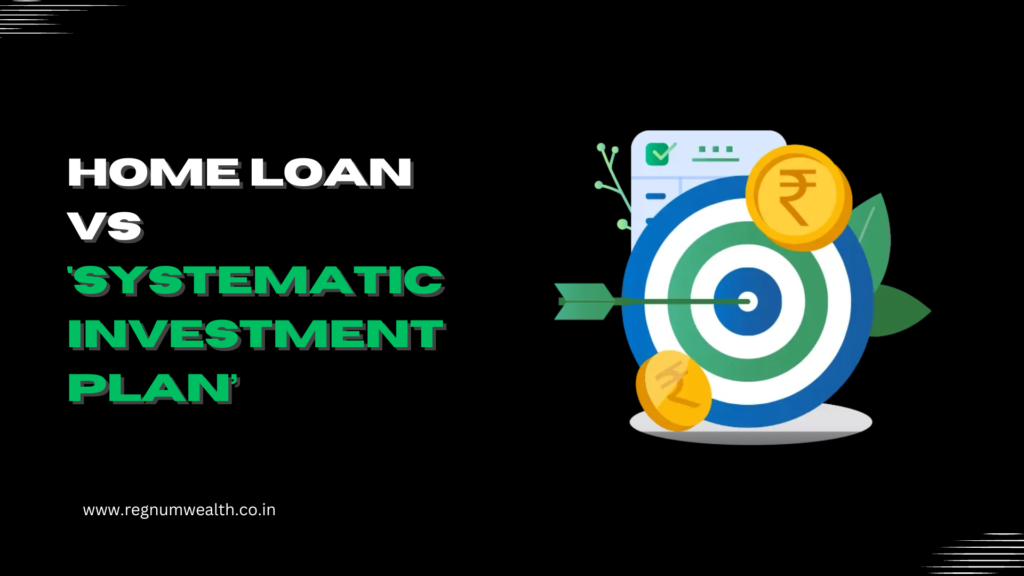
For most Indians, buying a home is a major milestone in their lives. However, given the steep rise in property prices, most people resort to taking a home loan to finance their dream home. On the other hand, mutual funds, specifically Systematic Investment Plans or SIPs, have also gained immense popularity in recent years as an investment tool. When is comes to picking between a higher home loan EMI or invest in SIP its often confusing for the investor.
What is EMI in a Home Loan?
EMI stands for Equated Monthly Installment. It is a fixed amount that a borrower pays to the lender every month to repay the loan. The EMI consists of both principal repayment and interest payment, and the proportion of each change over the loan tenure. Initially, a larger portion of the EMI goes towards interest, while the principal component gradually increases over time.Home Loan Calculator
What is SIP?
SIP stands for Systematic Investment Plan. It is a mode of investment where an investor invests a fixed amount at regular intervals, monthly, weekly, or daily, to buy units of a mutual fund scheme. SIP helps investors to save regularly with a smaller amount of money while benefiting from the long-term advantages of rupee-cost averaging. Rupee cost averaging means investing at different market levels, which reduces the impact of market volatility and lowers the average cost of investment.
Home Loan EMI Vs SIP
Home loan EMI is a fixed obligation you must pay monthly, regardless of your income or expenses. SIP is a flexible option that you can start, stop SIP or modify anytime, depending on your financial situation.
- Home loan EMI is how you pay off your debt over time, while SIP increases your wealth over time.
- Home loan EMI gives you tax benefits under Section 80C and Section 24 of the Income Tax Act, while SIP only provides tax benefits if you invest in tax-saving ELSS mutual funds.
- Home loan EMI has a fixed interest rate that you have to pay on the borrowed amount, while SIP has a variable return rate that depends on the performance of the mutual fund scheme.
- While home loan EMI is a way for you to own a home, SIPs offer the potential for wealth creation. When it comes to EMI vs SIP, both have their pros and cons. Let’s look at which option is better: Home Loan Vs SIP.
Scenario 1: Home Loan Vs SIP ( Long-Term Vs Short Term)
The two possible scenarios are opting for a long-tenure loan (with a lower EMI and investing the surplus amounts) or a short-tenure loan (higher EMI). The choice between long-term and short-term tenure for a loan will largely depend on your financial resources, obligations and objective. Here let’s break down both scenarios to understand them better.
Should I take a home loan of long tenure + lower EMI and invest the surplus?
Let’s take an example, Mr Sharma wants to take a home loan of INR 50 lakhs at an interest rate of 9% for 20 years (240 months). The EMI calculation can be done using the formula:EMI = P × r × (1 + r)^n / ((1 + r)^n – 1)where,P – loan amountr – monthly interest raten – loan tenure in months
| Loan Details | Amount |
| Loan Amount | INR 50 lakhs |
| Interest Rate | 9% |
| Loan Tenure | 20 years (240 months) |
| EMI | INR 44,986 |
| Total Interest Payable | INR 57,96,711 |
| Total Payment (Principal + Interest) | INR 1,07,96,711 |
Let’s assume Mr Sharma is comfortable paying INR 60,000 as EMI. Since the actual EMI amount is lower, he can choose to invest the remaining INR 15,014 (60,000 – 44,986) in mutual funds through SIP.
| SIP Investment Details | Amount |
| Monthly Investment Amount | INR 15,014 |
| Investment Tenure | 20 years |
| Expected Annualised Return | 10% |
| Expected Corpus | INR 1,14,96,173 |
By investing INR 15,014 per month for 20 years, Mr Sharma is able to generate a corpus of INR 1.15 crores. Thus, he is able to generate a significant corpus for his other financial goals.
Should I take a home loan of shorter tenure + higher EMI?
Here Mr Sharma takes a loan for 10 years and pays a higher EMI towards the loan.
| Loan Details | Amount |
| Loan Amount | INR 50 lakhs |
| Interest Rate | 9% |
| Loan Tenure | 10 years (120 months) |
| EMI | INR 63,338 |
| Total Interest Payable | INR 26,00,546 |
| Total Payment (Principal + Interest) | INR 76,00,546 |
Summary Table
| Option | A | B |
| Home Loan Amount | INR 50 lakh | INR 50 lakh |
| Interest Rate | 9% | 9% |
| Tenure | 20 years | 10 years |
| EMI | INR 44,986 | INR 63,338 |
| Total Interest | INR 57,96,711 | INR 26,00,546 |
| Total Amount | INR 1,07,96,711 | INR 76,00,546 |
| SIP Amount | Rs 15,014 | Rs 0 |
| Expected Annualised Return | 10% | 0% |
| Tenure | 20 years | 0 years |
| Maturity Value | INR 1,14,96,173 | Rs 0 |
The decision to opt for a longer or shorter home loan tenure depends on your resources, financial goals and risk tolerance levels. If you are comfortable with a higher EMI and can afford to pay it, opting for a shorter tenure will help you save on interest payments. In the above example, the interest payout in Option B is almost 50% less than in Option A. Also, opting for a higher EMI and closing the loan faster will help Mr Sharma save INR 38,95,627 (1,14,96,173 – 76,00,546) on his interest payouts. On the other hand, you can opt for a longer tenure if you prefer a lower EMI. In this case, you can invest the surplus amount in SIPs, which offer the potential for higher returns.
Scenario 2: Home Loan Vs SIP and without SIP
A: Invest 10% of EMI
Investing 10% of home loan EMI in SIP every month will help balance debt repayment and wealth creation goals. For example, Mr Kumar takes a home loan of INR 30,00,000 for a tenure of 20 years at 9%. His EMI will be Rs 26,992. He can choose to invest 10% of his home loan EMI in SIP every month. This way, he can balance his debt repayment and wealth creation goals. Thus, he can invest INR 2,700 per month in mutual funds through the SIP route for the same duration as his loan tenure.
| Option | Invest 10% of EMI | No Investment |
| Home Loan Amount | INR 30 lakh | INR 30 lakh |
| Interest Rate | 9% | 9% |
| Tenure | 20 years | 20 years |
| EMI | INR 26,992 | INR 26,992 |
| Total Interest | INR 34,78,027 | INR 34,78,027 |
| Total Amount | INR 64,78,027 | INR 64,78,027 |
| SIP Amount (10%) | INR 2,700 | INR 0 |
| Expected Annualised Return | 10% | 0% |
| Tenure | 20 years | 0 years |
| Maturity Value | INR 20,67,382 | INR 0 |
Assuming an annual return of 10%, Mr Kumar can accumulate INR 20 lakhs at the end of the period. This amount can be used to prepay the home loan partially or fully, depending on the outstanding balance. Alternatively, he can use this amount for any other financial goal, such as retirement, education or marriage.
B: Repay Home Loan Completely (Higher EMI) and Invest
Under this scenario, Mr Kumar can opt for a higher EMI of ~ INR 30,000 (26,992+2700). This way, he can repay his home loan in 15.5 years, i.e. 4.5 years early. Next, Mr Kumar can invest his EMI amount, i.e. INR 30,000 per month, in mutual funds through SIP. For a tenure of 4.5 years, the maturity value of the investment can potentially be INR 20.3 lakhs.
| Option | Higher EMI + SIP |
| Home Loan Amount | INR 30 lakh |
| Interest Rate | 9% |
| Tenure | 15.5 years |
| EMI | INR 30,000 |
| Total Interest | INR 25,73,508 |
| Total Amount | INR 55,73,508 |
| SIP Amount (10%) | INR 30,000 |
| Expected Annualised Return | 10% |
| Tenure | 4.5 years |
| Maturity Value | INR 20,30,934 |
Summary
| Option | Invest 10% of EMI | No Investment | Higher EMI + SIP |
| Home Loan Amount | INR 30 lakh | INR 30 lakh | INR 30 lakh |
| Interest Rate | 9% | 9% | 9% |
| Tenure | 20 years | 20 years | 15.5 years |
| EMI | INR 26,992 | INR 26,992 | INR 30,000 |
| Total Interest | INR 34,78,027 | INR 34,78,027 | INR 25,73,508 |
| Total Amount | INR 64,78,027 | INR 64,78,027 | INR 55,73,508 |
| SIP Amount (10%) | INR 2,700 | INR 0 | INR 30,000 |
| Expected Annualised Return | 10% | 0% | 10% |
| Tenure | 20 years | 0 years | 4.5 years |
| Maturity Value | INR 20,67,382 | INR 0 | INR 20,30,934 |
Here investing 10% of EMI every month scenario has the advantage of diversifying the portfolio and reducing dependency on a single asset class. It also helps in benefitting from the power of compounding and rupee cost averaging. However, this scenario also has some drawbacks. Mutual fund investments are subject to market risk and volatility. Capital gains from mutual funds are taxable as per the asset holding period and type of mutual fund.This approach aims to generate returns that offset the interest paid on the home loan. Thus making the home loan interest-free. By investing 10% of the EMI, individuals can reduce the effective interest paid over the loan tenure.On the other hand, paying a higher EMI (i.e., INR 30,000), closing the home loan sooner and investing in mutual funds is another beneficial scenario. It is always wise to repay your debt obligations as soon as possible, to reduce the interest payments. Here, by increasing the EMI by INR 3,008 (30,000 – 26,992), Mr Kumar is able to complete his home loan in 15.5 years than 20 years. He is able to save INR 9,04,519 on interest payments (34,78,027 – 25,73,508). Also, with INR 30,000 at his disposal, he can invest it in mutual funds for the remaining 4.5 years (54 months) or more and earn a 10% return. Therefore, for an investment of INR 16,20,000 (30,000 * 54), he can potentially generate INR 20.3 lakhs.Thus, by the end of his initial loan tenure of 20 years, Mr Kumar is able to save INR 9,04,519 on interest payments and generate INR 20,30,934 through mutual fund investments.
What is Home Loan Prepayment?
Home loan prepayment means paying off your home loan partially or fully before the end of the loan tenure. Home loan prepayment can help you save on interest costs and become debt-free sooner. Often, a lumpsum amount in the form of bonus, inheritance, or gift can be used to pre-pay the debt obligations. However, prepaying home loans will be beneficial only under certain circumstances. If the loan interest rates are high, prepaying the home loan as soon as possible is often better to avoid high-interest payments. Since the initial EMI payments comprise more of an interest component, it is wise to consider prepaying home loan. On the other hand, prepaying the home loan close to the end of the tenure may not be beneficial, as the major portion of the EMI will comprise of the principal amount. Thus, it may not have much impact on the interest outflow. The following are the things to consider before looking to prepay a home loan:
- Prepayment Penalty: Home loan lenders may not appreciate loan prepayments. Thus, they charge a penalty for prepayments.
- Tax Benefits: Home loan interest and principal payments qualify for tax exemption under Section 80C and Section 24 of the Income Tax Act.
- Opportunity to Invest: You may miss out on the opportunity to invest your money in other avenues that may give you higher returns than the home loan interest rate.
- Time of Prepayment: Prepaying a home loan in the initial stage will help reduce the interest outflow. Payouts closer to the end of the tenure comprise a higher principal component. Thus, prepaying the loan close to maturity may not be beneficial.
Home Loan Prepayment Vs SIP – Which is Best?
The decision of whether to choose home loan prepayment or SIP (Systematic Investment Plan) cannot be solely based on numbers. Several other factors come into play, which should be taken into consideration. Let’s explore these factors:
- Liquidity: If your primary objective is to enhance liquidity, investing in mutual funds would be more beneficial than prepaying the loan. For short-term liquidity needs, equity funds may not be suitable.
- Risk Capacity: It is crucial to consider your risk tolerance levels. Equity markets can be volatile, leading to fluctuating returns, including periods of negative returns. It requires patience to navigate through such market conditions.
- Emotional State: If being in debt is causing significant distress, and you desire to become debt-free as quickly as possible. Paying off the home loan would be preferable. Emotional factors play a role in this decision.
- Other Financial Goals: If you have other financial goals nearing tenures, investing might be more prudent than prepaying the loan. Assess your priorities and allocate funds accordingly.
Choosing between prepaying a home loan and investing in mutual funds is not a one-size-fits-all decision. It depends on individual circumstances and should be approached on a case-by-case basis. Therefore, it is essential to make an informed decision after carefully considering the aforementioned factors.
Home Loan Vs Sip Calculator
The Home Loan vs SIP calculator serves as a valuable tool for calculating expected loan EMIs, enabling you to plan your investments systematically, particularly through monthly SIPs. Prepaying a loan is often considered a preferable option as it directly reduces loan obligations and helps save on interest payments. However, it is crucial to objectively assess the benefits of prepaying a mortgage versus investing the extra funds in mutual funds.This objective comparison of EMI vs SIP will enhance your understanding as to which option is more suitable for your financial needs. Investing in mutual funds has the potential to generate higher returns. This, in turn, can help in achieving other financial goals. Using an EMI calculator, you can estimate the potential outflow with respect to your home loan. On the other hand, with the SIP calculator, you can estimate the potential returns from your investment. Thus, using both will hello you make plan your financial obligations and investments and make informed decisions.A home loan helps fulfil the dream of owning a house, and investing in SIPs offers the potential for long-term wealth creation. Individuals can make an informed decision that aligns with their financial objectives by analyzing different scenarios and considering factors such as loan tenure, EMI amount, and investment returns. The decision to opt for a longer or shorter home loan tenure depends on your financial goals and risk appetite. Additionally, investing a part of your EMI in SIPs can help you make your home loan interest-free over time. Ultimately, it is important to consult a financial advisor and understand your financial goals before making any investment decisions.



